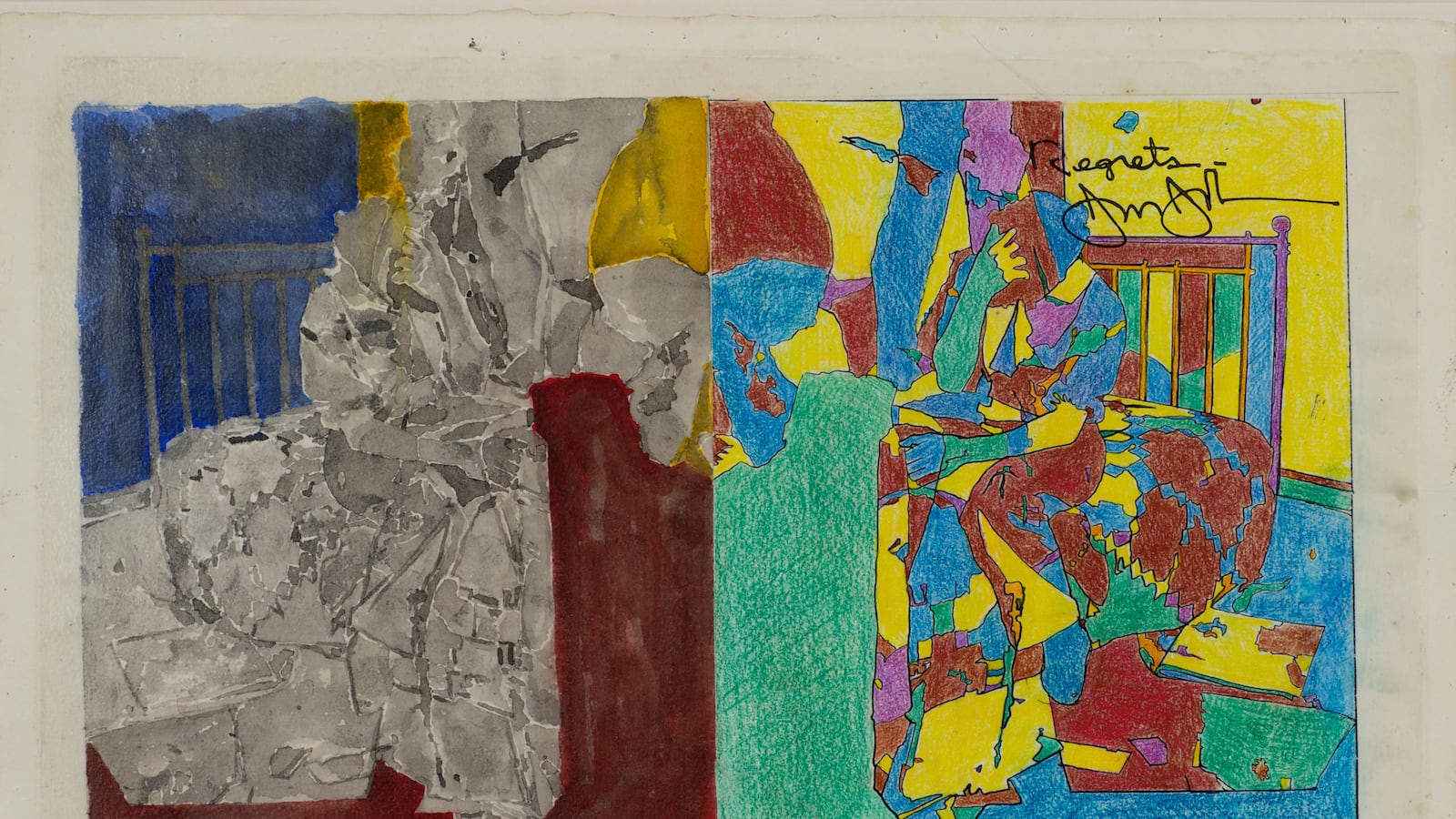
When an artist reaches high-profile status, it comes with many obligations. How do you deal with the flurry of invitations and requests that fills your mailbox—especially when you are notoriously reclusive? The artist Jasper Johns, famously known for his Flag painting from the 1950s, found an effortless and efficient solution to politely decline—a custom made stamp that reads “Regrets, Jasper Johns.”
Haphazardly, this stamp found its way into a completely new body of works, titled by the same name, now on view at the Museum of Modern Art.
Regrets maps out the evolution of two large-scale paintings, accompanied by various preliminary prints and drawings, that Johns began working on at the end of 2012. The central focus is a single photograph of British painter Lucian Freud.
Casually seated on a bed with his arm raised to obscure his face, the image of Freud was captured in 1964 by British photographer John Deakin on behalf of fellow Brit Francis Bacon, who famously paints from photographs instead of models.

Found among the many items in Bacon’s studio after his passing in 1992, it soon appeared in Christie's June 2012 auction catalog, where Johns, now 83, was immediately captivated by it. “This is the one that struck me,” Johns told Financial Times, “Bacon mistreated the photographs physically, is what it looks like. I just saw that and it caught my eye.” The print had been torn, folded and creased until a large void was left in the lower left portion. This void became the unlikely key component of Johns’ newly produced works.
“It’s the star of all the images,” co-curator Ann Temkin said. “[It’s] part of what sustains the mystery that is really the engine for what keeps all of these works going.” Johns took the original source and mirrored it horizontally, creating a large missing void in the center of the work. From this technique, the artist was able to revisit the image with new ideas, creating a perpetual body of work that might have normally concluded after the first rendering.
Johns, who was raised in South Carolina, moved to New York in 1948. After a brief stint on active duty in the Korean War, the artist began to focus full-time on his artistic endeavors resulting in his first show at the Castelli Gallery in 1958. Flag—the infamous depiction of the American symbol—that was exhibited immediately put the artist on the map as a forerunner in a new post-war movement leading away from the Abstract Expressionists like Jackson Pollock, laying the groundwork for both Pop Art and Minimalism.
His works continued to include immediately recognizable images—maps, targets, numbers—as well as ready-made objects, many of which are owned by major international museums and have been showcased in exhibitions around the world. More recently, Johns’ name filled news headlines in 2012 when it came to light that his long-time assistant, James Meyer, had allegedly been stealing and selling unfinished works from his studio in Sharon, Connecticut.
While visiting the artist, the curators candidly asked Johns to allow MoMA to debut his newest, and then unfinished, collection. “[It] was certainly a unique experience for us,” Temkin said. “We decided on the spot upon seeing these new works for the first time.” This was a rather unique decision for the museum as it is known for exhibiting large-scale retrospectives and surveys years in the making.
“What we wanted to do was to try and convey [to the viewers] the impression we had in the studio,” co-curator Christophe Cherix said, remembering the visit.

The works are shown sequentially, opening with the original photo of Freud in all its tattered glory. Piece by piece, Johns’ process is revealed. There is a photocopy collage of the mirrored image divided by bright colors to the right and a more muted palette to the left. Individual sketches reveal how Johns experimented with different techniques, trying to capture the right combinations. These sketches evolve into larger, more intense ink prints that deepen and fade with each additional attempt.
The resulting two canvas paintings are refreshingly new but subtly familiar. Their styles and composition are dark, both in color and form. A skull forms through the mirroring of the original image and hovers above the large negative shape. The vibrant colors typical of Johns’ expressionist work appear only briefly in one of the paintings. However, the many facets filling the contour lines that appeared as wrinkles on the original photograph are references to Johns’ historical oeuvre—most notably references to his crosshatch works from the 70s.
“He’s really playing with our capacity to look at an image,” Cherix said. “To try and decipher something that we know, but bring us further in our understanding not only of the image, but the painting. I think that’s one of the things which bring all of these works together.”
Jasper Johns: Regrets is on display at the Museum of Modern Art in New York until September 1, 2014.






